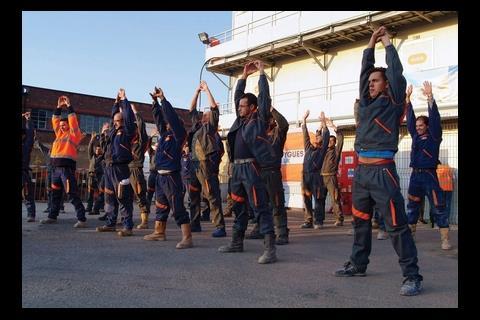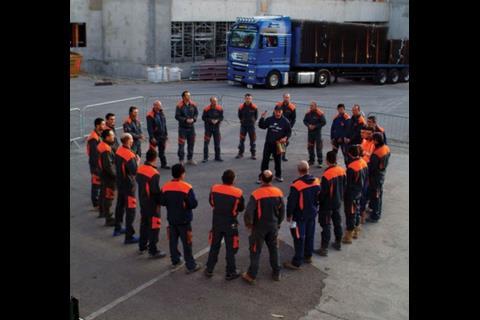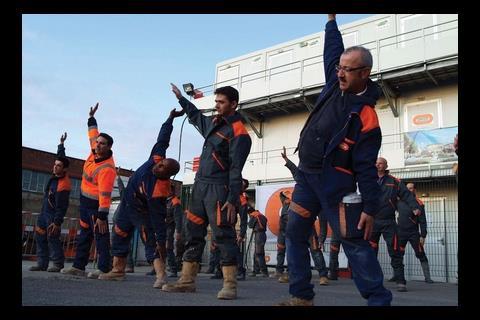Warming up before work used to mean eating your bacon buttie while it was still hot. But now, in an effort to cut down site injuries, Bouygues UK has stepped things up a gear.
It is 7am and a wintry sun is slowly rising above a strange scene. In an industrial yard, a group of 25 men are standing in two lines, all dressed in matching orange and blue. Without warning, as one, they start swinging their arms in a perfectly co-ordinated motion ŌĆ”
You may be forgiven for thinking you had inadvertently stumbled upon a boyband rehearsal, or perhaps a cult ritual. The truth, while marginally less exciting than that, is still fairly eyebrow-raising: the men are jumping, squatting, stretching and even buttock-squeezing all in the name of improving health and safety on site.
This unlikely scene is one of two daily morning warm-up sessions being trialled by Bouygues UK in this country: at the Broomfield Hospital project in Chelmsford, Essex, and here, on the North Middlesex University Hospital site in north London.
The French contractor first caught the fitness bug after a survey revealed that a disportionate amount of site injuries occur between 8am and 9am. At this time, workersŌĆÖ muscles are cold, increasing the chance of them being torn or damaged.
Figuring that a bit of exercise first thing would solve this problem, two years ago Bouygues introduced 15-minute warm-ups for workers in France. The exercise regime focuses on the body parts most affected by work on a construction site, mainly the joints and back. It turned out to be a resounding success, resulting in a fall in site injuries and a roll-out of the scheme nationwide.
It may have gone down well in France, but then, Johnny Hallyday goes down well in France. The question is, how will site workers in Britain react?
The men here in London seem to be getting into the spirit. As they come to part four (back care), I grab a word with Bouygues UK project director at North Middlesex, Gerald Farque. He is evangelical about the scheme, and reckons all contractors should be doing it ŌĆō a view reinforced by the fact that handling, lifting and carrying-related injuries account for 38% of all over-three-day absences in the UK construction industry.
ŌĆ£The benefits are there for everyone to see,ŌĆØ Farque says. ŌĆ£We put measures in place to stop crane accidents, or to protect ourselves from falling objects. Why not protect our men from musculoskeletal injuries?ŌĆØ
The lads on site are also positive. ŌĆ£ItŌĆÖs fun,ŌĆØ says Jos├® Marques, 29, from Portugal. ŌĆ£Every day it makes us laugh.ŌĆØ
He says itŌĆÖs also improving his fitness: ŌĆ£ItŌĆÖs helped my aches, my muscle pain. I feel much fitter.ŌĆØ He says the exercises have especially helped the smokers on the project, with many of them now finding breathing while working much easier.
Vullent Hoxna, 32, from Albania, is also a fan. ŌĆ£I used to get pain in my back and shoulders, but this has really helped. I feel fitter; I feel I am getting younger,ŌĆØ he laughs.
On site today, the workforce comprises five or more nationalities, but it remains to be seen whether the scheme ŌĆō which isnŌĆÖt compulsory ŌĆō could become the norm for a largely British workforce.
I used to get pain in my back and shoulders, but this has really helped. I feel I am getting younger!
Vullent Hoxna, 32
Phil Olding is managing director of New Leaf Health, the corporate health provider running the regime for Bouygues. He admits he is unsure how a site mainly made up of British workers would receive the warm-up sessions. ŌĆ£Culturally, this would be interesting,ŌĆØ he says. ŌĆ£I think it would need to become part of health and safety compliance for it to be sustainable.ŌĆØ
The test will come soon when British subcontractors start working at the North Middlesex site. Farque says he hopes they join in. ŌĆ£I think theyŌĆÖll buy into it once they know what the benefits are,ŌĆØ he insists, looking slightly unconvinced. ŌĆ£After all, itŌĆÖs no different to doing it on a football pitch, is it?ŌĆØ
But he does have reservations. ŌĆ£ItŌĆÖs a question of communication ŌĆō weŌĆÖll have to explain exactly why weŌĆÖre doing it.ŌĆØ
Meanwhile, the warm-up is reaching what looks like some kind of complicated climax. The men have formed a ring around the instructor. He hands out coloured batons, which are passed around the group until he blows his whistle. When youŌĆÖre given the baton, you have to break the circle and run around it until youŌĆÖre back in your spot. ItŌĆÖs like musical chairs as interpreted by a school games teacher. There is shouting and clapping, and a lot of laughing. Surely even the most cynical British site worker would have to giggle at this scene? You never know, the Bouygues warm-up might just catch on.
This article appeared in ║├╔½Ž╚╔·TV magazine under the title: Eat your heart out, Jane Fonda.

Postscript
Original print headline "Eat your heart out, Jane Fonda"































No comments yet